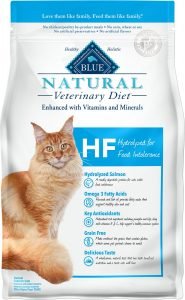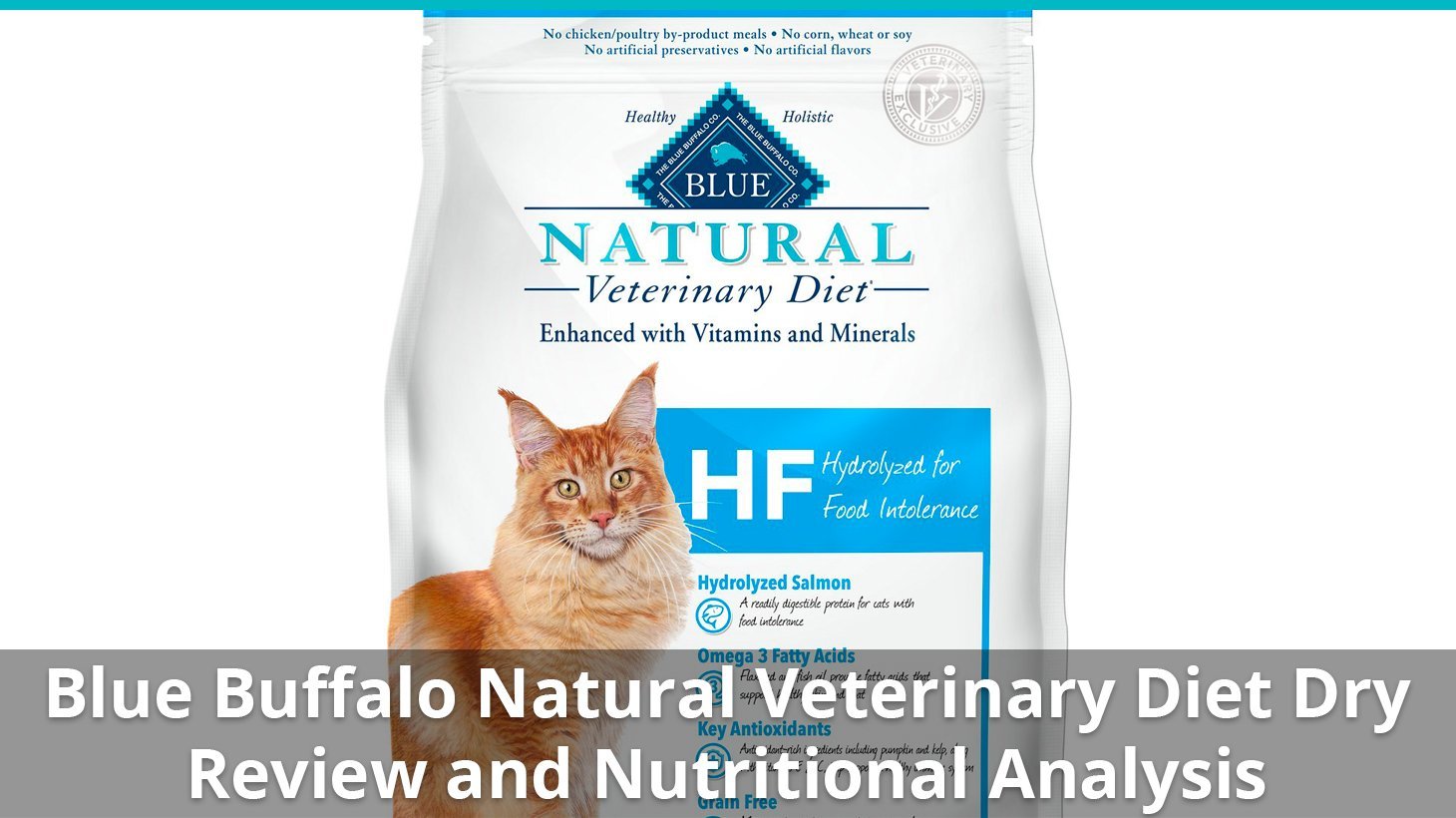Our review process is unbiased and based on extensive research. If you buy through the links on our site, we may earn a commission.
Rating
- Meat is the first ingredient – 1 Star
- Uses some unnamed meats – 1 Star
- Above average protein content – 0 Star
- Less than 4 controversial ingredients – 0 Star
- Catological Discretionary Rating – 0 Star
Here’s a few important points to consider for this particular line:
- Meat is the first ingredient
- Contains a lot of fillers, thickening agents, and plant-based protein boosters
- These require a prescription from a vet to purchase
- Most big-brand “veterinary” formulas are based on marketing, not science – This is one example of a low quality recipe being labeled as a veterinary recipe
- Includes extra vitamins, and high quality, chelated minerals, and some include probiotics
The Veterinary Diet product line includes 4 dry recipes/flavors.
Each recipe below includes its related AAFCO nutrient profile when available on the product’s official webpage or packaging: Growth (G), Maintenance (M), All Life Stages (A), Supplemental (S) or Unspecified (U).
The star rating is a rough average of all of the flavors in a single line of food. If an individual recipe scored lower or higher, we will mark that below, next to the flavor.
- Blue Buffalo Natural Veterinary Diet GI Gastrointestinal Support (M)
- Blue Buffalo Natural Veterinary Diet HF Hydrolyzed for Food Intolerance (M)
- Blue Buffalo Natural Veterinary Diet KM Kidney + Mobility Support (M)
- Blue Buffalo Natural Veterinary Diet WU Weight Management and Urinary Care (M) 2.5 stars

Blue Buffalo Natural Veterinary Diet HF Hydrolyzed for Food Intolerance was selected to represent the other products in the line for this review.
Blue Buffalo Natural Veterinary Diet HF Hydrolyzed for Food Intolerance
Dry Cat Food
| Estimated Nutrient Content |
| Protein | Fat | Carbs | |
|---|---|---|---|
| Guaranteed Analysis | 30% | 14% | NA |
| Dry Matter Basis | 33% | 15% | 38% |
| Calorie Weighted Basis | 30% | 34% | 35% |
Estimated Dry Matter Nutrient Content
Fiber (guaranteed analysis)
4%
Calories/100g
372
Is real, named meat the first ingredient?
Yes
Ingredients
Salmon Hydrolysate, Peas, Potatoes, Pea Starch, Canola Oil (source of Omega 6 Fatty Acids), Pea Protein, Flaxseed, Pea Fiber, Natural Flavor, Dicalcium Phosphate, Calcium Sulfate, Fish Oil (source of Omega 3 Fatty Acids), Choline Chloride, Calcium Carbonate, DL-Methionine, Pumpkin, Dried Kelp, Calcium Chloride, Salt, Dried Chicory Root, Taurine, Potassium Sulfate, L-Threonine, Vitamin E Supplement, preserved with Mixed Tocopherols, L-Tryptophan, Potassium Chloride, L-Carnitine, L-Ascorbyl-2-Polyphosphate (source of Vitamin C), Iron Amino Acid Chelate, Zinc Amino Acid Chelate, Niacin (Vitamin B3), Copper Amino Acid Chelate, Manganese Amino Acid Chelate, Thiamine Mononitrate (Vitamin B1), Biotin (Vitamin B7), Vitamin A Supplement, Pyridoxine Hydrochloride (Vitamin B6), Calcium Pantothenate (Vitamin B5), Riboflavin (Vitamin B2), Vitamin D3 Supplement, Vitamin B12 Supplement, Folic Acid (Vitamin B9), Dried Yeast, Dried Enterococcus faecium fermentation product, Dried Lactobacillus acidophilus fermentation product, Dried Aspergillus niger fermentation extract, Dried Trichoderma longibrachiatum fermentation extract, Dried Bacillus subtilis fermentation extract, Calcium Iodate, Sodium Selenite, Oil of Rosemary.
Ingredients in red are controversial or of questionable quality.
Ingredient Breakdown
The first ingredient in this cat food is salmon hydrolysate. OK, but with reservations.
Salmon is a good source of omega 3 and 6 fatty acids.
Fish oils support the health of the skin, coat, joint, kidneys, heart, and immune system, and may even help with serious illnesses such as cancer.
However, do we not believe cats should be fed a diet high in fish.
Cats may be allergic to fish, fish may contain toxins from contaminated waters, and in the wild, it is not common to find cats who eat fish, even if they live close to water.
Here’s what salmon hydrolysate means, according to a study in Animal Feed Science and Technology: “fresh by-products from farmed salmon are minced and mixed with formic acid until the pH value has stabilized between 3.5 and 4.0. At this pH range, proteases in the salmon tissue such as pepsin are able to hydrolyse the proteins into peptides and free amino acids.”
Basically, it makes the protein more digestible, which may help animals with digestive issues.
The second ingredient is peas. Bad.
Peas are a quality carbohydrate, but cats don’t need much in the way of carbohydrates.
They are full of fiber, but also contain a fair amount of protein, which we should keep in mind when judging the meat content of this food.
This is one of four pea ingredients in this recipe, which means together, pea is likely the #1 ingredient.
The third ingredient is potatoes. Bad.
These are typically used as filler in grain-free recipes.
They are not biologically appropriate and may cause digestive upset.
The fourth ingredient is pea starch. Bad.
This part of the pea has no fiber or protein, and is usually used as a thickener and filler ingredient.
The fifth ingredient is canola oil. Good.
A filler high in insoluble fiber. It’s typically wood pulp (sawdust) from pine trees.
Too much insoluble fiber can interfere with digestion and inhibit protein and nutrient uptake.
The sixth ingredient is pea protein. Bad.
Peas are a quality carbohydrate, but cats don’t need much in the way of carbohydrates.
Peas are also rich in protein, and this ingredient is a concentrated form of that protein, which means the actual meat content of this food may be lower than the macronutrient profile suggests.
Peas are not the worst carbohydrate your cat can consume, but they’re simply not at all biologically appropriate.
The seventh ingredient is flaxseed. Good.
Flaxseed provides a quality omega-3 fatty acid source, and nutritive fiber to the recipe.
It can only be digested when the outer shell is removed or destroyed, but there is no information given in this ingredient to determine if it is made bioavailable by grinding or flaking.
The eighth ingredient is pea fiber. Bad.
Pea fiber is high in insoluble fiber.
It is not a biologically appropriate ingredient for cats, and is a filler ingredient to boost fiber content.
This recipe includes a number of other ingredients, but once you get down this far, none of them will be in large enough quantities to make a real difference, except for the added vitamins and minerals.
However, there are a few things you should know about.
This recipe utilizes chelated minerals, which may be easier to digest and more bioavailable for your cat. This is usually a sign of a high quality cat food.
The label says it includes oil of rosemary. If this is true, this is a potentially dangerous ingredient.
Most cat foods include rosemary extract, which is a useful natural preservative.
However, oil of rosemary can be harmful to cats.
The essential oil derived from rosemary is useful for topical application, but can become toxic at higher doses when ingested.
We wonder if this might be a misprint on the label, as Blue Buffalo is the only company to include it on their label.
To read a more in depth article about any of the ingredients listed here, check out our Cat Food Ingredient Wiki (currently under development).
The Catological Verdict on Blue Buffalo Veterinary Diet Dry Cat Food
From top to bottom, this is a below average dry product.
Meat is the first ingredient, but fillers make up a large portion of the recipe. If you include all pea ingredients as one ingredient, it’s almost certain they would be the first ingredient.
The macronutrient contents of these foods are not ideal.
This is a not a good example of a dry food you should be feeding to your cat.
Based on the ingredients and the macronutrient profiles, meat is most likely NOT the main ingredient, and we can therefore say it’s a mostly plant-based cat food, which is not biologically appropriate for your kitty.
To review, on a dry matter basis, this food is 33% protein, 15% fat, and 38% carbs.
As a group, the brand has an average protein content of 36%, and average fat content of 16%, and an average carb content of 32%.
Compared to the other 2000+ foods in our database, this food has:
- Below average protein.
- Average fat.
- Above average carbs.
Because meat comes first, but fillers are plentiful, our average rating for this brand is 2 stars.
Not recommended.
Blue Buffalo Cat Food Recall History
We do not believe that a recall indicates a low quality food or company, and we respect the fact that sometimes things happen that cause a manufacturer to recall a food.
Usually these things are non-life-threatening, and we think it’s important to take a moment to be thankful about just how few recalls there really are in the industry, considering the enormous volume of food produced.
However, we do believe that a history of recalls may point to a larger issue with a company, and that discerning consumers want to know who they’re buying from, especially when it comes to something as important as the food you feed your beloved cat.
Here is a list of recalls that have affected the Blue Buffalo brand in the past:
- March 2017 – Potential high levels of beef thyroid hormone (naturally occurring) – 1 recipe affected
- February 2017 – Potential alluminum contamination – 1 recipe affected
- February 2017 – Packaging quality – 2 lines of dog food affected
- May 2016 – Potential mold – 1 recipe affected
- November 2015 – Potentially contains propylene glycol – 1 cat food recipe affected
- November 2015 – Potential for salmonella – 1 recipe affected
- October 2010 – Potentially too much vitamin D – 3 lines of dog food affected
- April 2007 – Melamine – Most recipes affected
- NOTE ON LAWSUIT – A class action lawsuit was levelled against Blue Buffalo in 2017, alleging high levels of lead in their products. This is working it’s way through the legal system, and these allegations are not proven.
If you want to stay up to date on the latest recall information affecting your cat’s food, sign up to our email list and receive an email every time a recall is announced. We’ll also let you know about any updated ratings, recipe changes, or new cat foods on the market. (Our alert system will be launched shortly, check back soon.)
Where To Buy Blue Buffalo Cat Food
We recommend purchasing your pet products from Chewy.com. They continually prove that they walk the walk while talking the talk, and I’ve never dealt with a more dedicated pet-parent base of people than those who work at Chewy.
Plus, they offer 20% off and free shipping on lots of orders.

